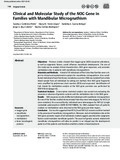Clinical and Molecular Study of the NOG Gene in Families with Mandibular Micrognathism

Fecha
2021-09-30Autor(es)
Gutiérrez-Prieto, Sandra J.Torres-López, Diana María
García Robayo, Dabeiba Adriana
Rey-Cubillos, Jorge A.
Gomez, Mariluz
Autor(es) Corporativo(s)
Pontificia Universidad Javeriana. Facultad de Medicina. Instituto de Genética Humana. Grupo de investigación Instituto de Genética Humana
Tipo
Artículo de revista
ISSN
1305-7456
COAR
Artículo de revistaCompartir este registro
Citación
Documentos PDF
Abstract
Objectives: Previous studies showed that noggin gene (NOG) sequence alterations, as well as epigenetic factors, could influence mandibular development. The aim of this study was to analyze clinical characteristics, NOG gene sequences, and promoter methylation sites in patients with mandibular micrognathism.
Materials and Methods: A total of 35 individuals of five Colombian families were subject to clinical and cephalometric analysis for mandibular micrognathism. One nonaffected individual of each family was included as a control. DNA was isolated from whole blood sample from all individuals by salting out method. Nine NOG gene fragments were amplified by polymerase chain reaction (PCR) and sequenced. Identification of CpG islands for methylation analysis at the NOG gene promoter was performed by MSP-PCR kit (Qiagen R).
Statistical Analysis: A descriptive statistical analysis was carried out evaluating the presence or absence of genetics variants and the methylation sites in the NOG gene.
Results: NOG sequence results of affected individuals with mandibular micrognathism for one of the families studied demonstrated that they were heterozygous for 672 C/A (new mutation). For a second family, individuals were heterozygous for 567 G/C (single nucleotide polymorphism [SNP] RS116716909). For DNA analyzed from all patients studied, no methylations were observed at the NOG gene promoter region.
Conclusion: Our results suggested that 672 C/A and 567 G/C variants could be involved in the presence of mandibular micrognathism. Moreover, lack of methylation sites at the NOG gene promoter region of all individuals studied suggests possibly other epigenetic factors could modulate mandibular growth. The search of genetic variants related with mandibular micrognathism will allow to predict in an integral way the development patterns of the patients and therefore establish a better clinical treatment.
Cobertura espacial (Ciudades)
Bogotá (Colombia)Cobertura espacial
ColombiaComunidad
Pacientes con Micrognatismo mandibularFuente
European Journal of Dentistry; Volumen 15 Número 4 , Páginas 746 - 754 (2021)
Estadísticas Google Analytics
Colecciones
- Artículos [485]

